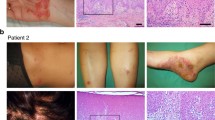Summary
The effects of local and systemic administration of tumour necrosis factor (TNF) on the mouse-tail model of psoriasis were examined histologically at 4 days after administration. Subcutaneous injection of TNF at 1×101 to 1×104 units/mouse resulted in dose-dependent formation of a granular layer in the tail scales, which was quantified as the percentage of tail scales having granular layer formations extending over half or more of their surface and was larger than that occurring in untreated mice and in mice receiving injections of vehicle solution alone. Daily intraperitoneal injection of TNF at 1×103 or 1×104 units/mouse for 28 days resulted in similar granular layer formation and in a significantly reduced mitotic index of the tail keratinocytes, indicating an antiproliferative effect of TNF. The lowered mitotic index and the induction of granular layers, apparently attributable to a modulation of keratinocyte proliferation and differentiation by TNF, suggest that TNF may be effective as a drug for treatment of psoriasis.
Similar content being viewed by others
References
Bladon PT, Taylor M, Wood EJ, Cunliffe WJ (1985) Effect of crude coal tar in the mouse-tail model of psoriasis. Arch Dermatol Res 277:121–125
Carswell EA, Old LJ, Kassel RL, Green S, Fiore N, Williamson B (1975) An endotoxin-induced serum factor that causes necrosis of tumors. Proc Natl Acad Sci USA 72:3666–3670
Lawrence DJ, Bern HA (1958) On the specificity of the response of mouse epidermis to vitamin A. J Invest Dermatol 31:313–325
Pillai S, Bikle DD, Eessalu TE, Aggarwal BB, Elias PM (1989) Binding and biological effects of tumor necrosis factor alpha on cultured human neonatal foreskin keratinocytes. J Clin Invest 83:816–821
Shirai T, Yamaguchi H, Ito H, Todd CW, Wallace RB (1985) Cloning and expression in Escherichia coli of the gene for human tumour necrosis factor. Nature 313:803–806
Spearman RIC, Garretts M (1966) The effects of subcutaneous saline injections on growth and keratinization of mouse tail epidermis. J Invest Dermatol 46:245–250
Symington FW (1989) Lymphotoxin, tumor necrosis factor, and gamma interferon are cytostatic for normal human keratinocytes. J Invest Dermatol 92:798–805
Wrench R, Britten AZ (1975) Evaluation of coal tar fractions for use in psoriasiform diseases using the mouse tail test. I. High and low temperature tars and their constituents. Br J Dermatol 92:569–574
Wrench R, Britten AZ (1975) Evaluation of coal tar fractions for use in psoriasiform disease using the mouse tail test. II. Tar oil acids. Br J Dermatol 92:575–579
Wrench R, Britten AZ (1975) Evaluation of coal tar fractions for use in psoriasiform diseases using the mouse tail test. III. High boiling tar acids. Br J Dermatol 93:67–74
Author information
Authors and Affiliations
Rights and permissions
About this article
Cite this article
Nagano, K., Hori, K., Nagane, T. et al. Effect of tumour necrosis factor in the mouse-tail model of psoriasis. Arch Dermatol Res 282, 459–462 (1990). https://doi.org/10.1007/BF00402623
Received:
Issue Date:
DOI: https://doi.org/10.1007/BF00402623




